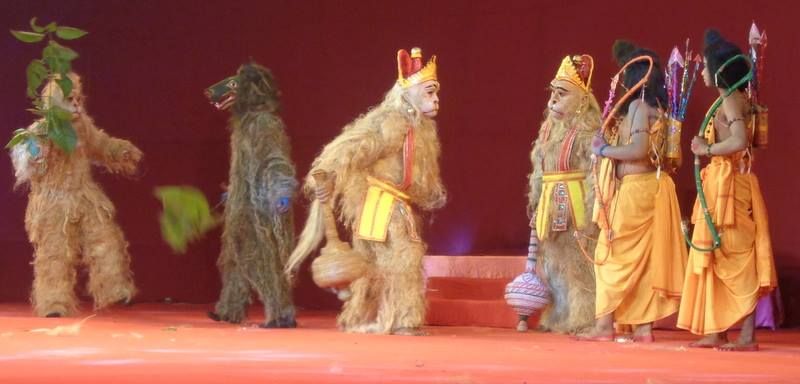Amid the Covid-subdued Ramlila season of 2020, IAR takes a view of its Muslim artistes. Also, a quick glance at similar participation of the community in the Yakshagana theatre of the south.
She isn’t demure, but appears truly earnest in her conduct. However, Lakshmana is not impressed with the pretty woman’s requests to meet his elder brother. A spat ensues and, at one point, the sword-wielding man cuts the nose of the guest.
That reveals her identity as a demoness: Shurpanakha. Dramatically, there enters a grotesque-looking character in the next scene. With a mash of make-believe flesh hanging till her lips, the woman delivers a long speech, vowing to take revenge on the couple—Rama and Sita, seen on the stage that is now their hermitage in the forest.
This is a famed scene from Yakshagana, a pre-classical dance-theatre from southwest India. The art-form, endemic to south Karnataka and areas north Malabar’s Kasaragod, typically follows themes from Hindu mythology. Here, of course, it’s a slice from the Ramayana.
The epic has its equally popular idiom of presentation upcountry. Ramlila. It’s a folksier enactment of the Purana, with the lyrics sticking to Ramcharitmanas. That is written in an eastern Hindi language called Awadhi by bhakti stalwart Goswami Tulsidas (1532-1623).
Yakshagana, though, has its poems (prasanga) penned by not one author. Also, the drama from Deccan has its lyrics sung by a vocalist with his musicians in the backdrop even as the characters chip in with dialogues. Contrastingly, Ramlila’s stage artistes, with largely realistic make-up and costume, double as musicians. They require talent in singing.
Rahims of Ramlila
The scope of this two-part feature is confined to the active participation of non-Hindus in the two art-forms. Pleasantly interesting, given that the themes of the art are from the Puranas.
To begin with, Lucknow has a Muslim family that has been organising Ramlila for the past half-a-century, passing the legacy down its three generations. Its head, Mohd Sabir Khan, was an early teenager when he debuted on the Ramlila stage way back in 1972.
The endeavour matured. Today, the troupe has artistes from the Hindu and Muslim communities. They include Khan’s two sons and his grandchildren. “God did not divide people as Hindus and Muslims. We are all one, as brothers,” Khan was quoted as saying while speaking to a news agency during the 2018 Dussehra festivities. “Above all, we are human beings.”
Notwithstanding a general change in the attitudes of the two communities towards each other since the 1990s, the joint participation at the Ramlila continues with the people in Khan’s area of Bakshi Ka Talab.
Upcountry, Chandigarh has artistes from the Islamic faith in its Ramlila committees. In 2015, when the show was on at Mani Majra, a teenaged engineering student from a Muslim family essayed the role of Sita. A little away in the City Beautiful, at Sector 28, two uncles of the youngster essayed prominent roles when the local Garhwal Ramlila Committee staged the art.
Miraz Malik, who was 17 then, said youngsters were becoming open to each other’s customs. “In any case, Ramlila goes beyond religion,” he added.
Punjab and Beyond
Further northward, Punjab’s Patiala district has a town called Rajpura. There, for the past 22 years, it’s, again, a Muslim family organising Ramlila. Middle-aged Faqir Mohammad, as its head, recalls his initial tryst with the Ramlila at the pandal as a child. So enchanted was the boy with the ambience he began assisting the organisers in what little ways he could at the tent pitched by the local Sri Adarsh Mahavir Club.
Into the present century, the organisation closed down, only to branch off into two societies. Mohammad went on to helm one of them called Shree Ram Parivaar Society.
Mohammad is reasonably well off today, in contrast with his formative years in the household that, in the late 1940s, moved into Rajpura from a village not very far. From eking out a life as a roadside tailor, he later ran a gas agency. Of late, Mohammad is a road patti contractor. The changes in profile apart, the man continues with his namaaz at the local masjid.
Still up the map, late Mohammed Amin Sourawardi of Jammu region is renowned for his translation of the Ramayana into Urdu in the last century for the enactment of Ramlila on stage. Sourawardi was 96 when he died in 2008, five decades after his epochal work that continues to give voice to Ramlilas in his native Doda.
Back in the plains of Uttar Pradesh, Mathura in the west to Jaunpur in the east (near Varanasi) besides Faizabad, the headquarters of the district that sports lord Rama’s Ayodhya, too have Muslim artistes performing Ramlila.
This is Part 1 of a two-part series

